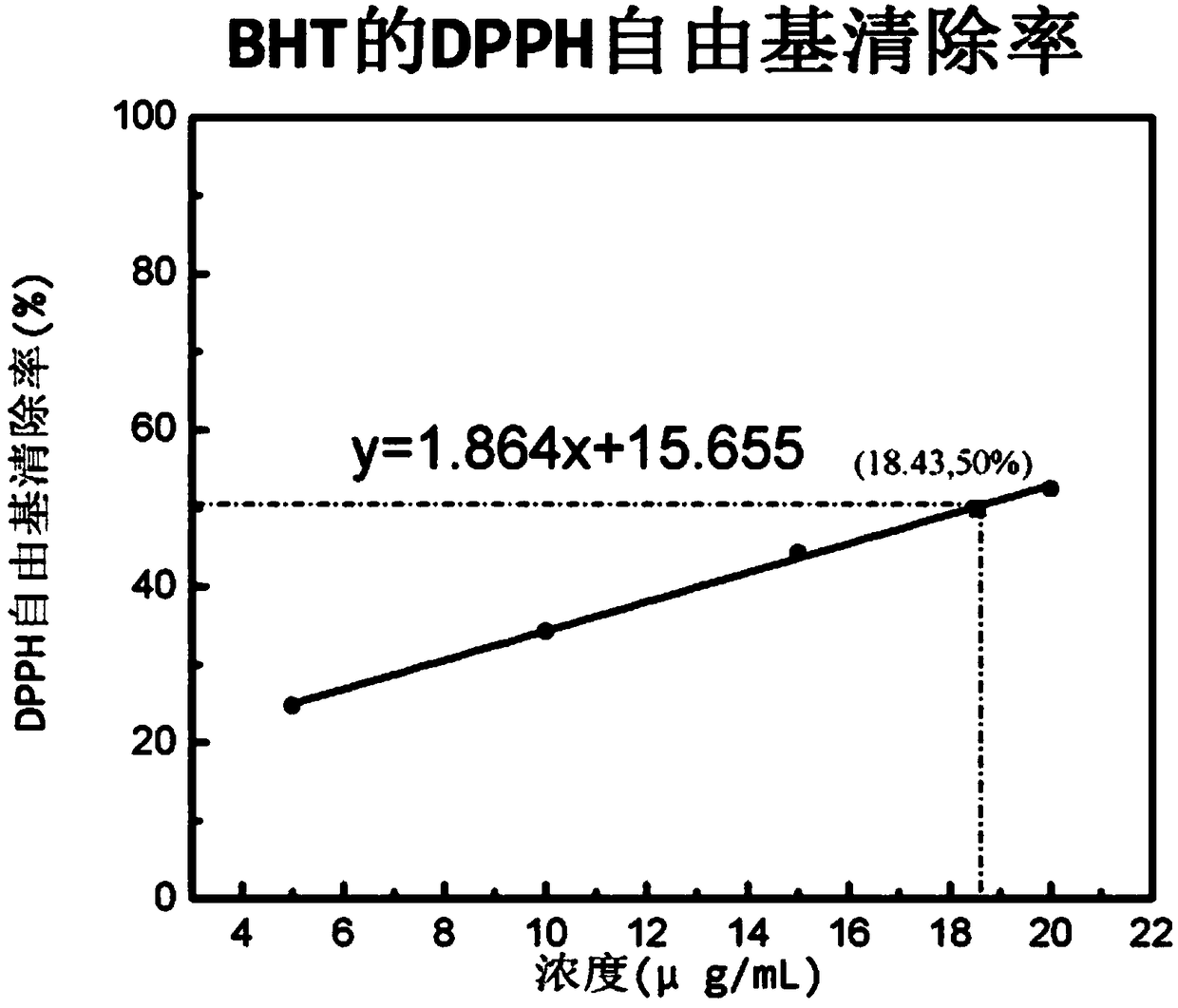Thioether type compound as well as synthesis method and application thereof
A synthesis method and compound technology, applied in the preparation, application, food science and other directions of thioether, can solve the problems of adverse effects of antioxidant capacity, limited application scope, low antioxidant efficiency, etc., and achieve excellent antioxidant capacity, non-toxicity, etc. Side effects, mild process conditions
- Summary
- Abstract
- Description
- Claims
- Application Information
AI Technical Summary
Problems solved by technology
Method used
Image
Examples
Embodiment 1
[0045] Synthesis of compound (I-1):
[0046]
[0047] In a three-necked flask with a thermometer, a magnetic stirrer and a reflux condensing device, add 12 g of acetic acid, 8.2 g of sodium acetate, and 200 mL of deionized water, and stir to dissolve; then add 3-methoxy-4-hydroxybenzyl alcohol (II -1) 12.4g, 7.90g of sodium thiosulfate, continue to stir, and heat to 95°C for 15h. After cooling down, add 200mL dichloromethane to extract twice, dry with anhydrous sodium sulfate, filter, and concentrate under reduced pressure to obtain a bright yellow oil; then add 200mL of 50% ethanol solution for recrystallization to obtain pure product: bis(3- Methoxy-4-hydroxybenzyl)sulfide 8.13g product, yield 66.0%. The melting point of the product is 79.5-82.2°C,1 H-NMR (400MHz, CDCl 3 )δ: 6.847 (2H, s, H-3, 3'), 6.813 (2H, d, J=1.2MHz, H-5, 5'), 6.751 (2H, d, J=1.2MHz, H-6 ,6'), 3.877 (6H, s, CH3), 5.558 (2H, s, OH), 3.557 (4H, s, CH2), 7.26 (CDCl 3 solvent peak).
Embodiment 2
[0049] Synthesis of compound (I-1):
[0050]
[0051] In a three-necked flask with a thermometer, a magnetic stirrer and a reflux condensing device, add 12 g of acetic acid, 8.2 g of sodium acetate, and 200 mL of deionized water, and stir to dissolve; then add 3-methoxy-4-hydroxybenzyl alcohol (II -1) 12.4g, potassium thiosulfate 9.52g, continue to stir, and heat to 100°C for 12h. After cooling down, add 200mL dichloromethane to extract twice, dry with anhydrous sodium sulfate, filter, and concentrate under reduced pressure to obtain a bright yellow oil; then add 200mL of 50% ethanol solution for recrystallization to obtain pure product: bis(3- Methoxy-4-hydroxybenzyl)sulfide 8.82g product, yield 71.6%. The melting point of the product is 79.5-82.2°C, 1 H-NMR (400MHz, CDCl 3 )δ: 6.847 (2H, s, H-3, 3'), 6.813 (2H, d, J=1.2MHz, H-5, 5'), 6.751 (2H, d, J=1.2MHz, H-6 ,6'), 3.877 (6H, s, CH3), 5.558 (2H, s, OH), 3.557 (4H, s, CH2), 7.26 (CDCl 3 solvent peak).
Embodiment 3
[0053] Synthesis of compound (I-1):
[0054]
[0055] In a three-necked flask with a thermometer, a magnetic stirrer and a reflux condensing device, add 12 g of acetic acid, 8.2 g of sodium acetate, and 200 mL of deionized water, and stir to dissolve; then add 3-methoxy-4-hydroxybenzyl alcohol (II -1) 12.4g, 5.93g of ammonium thiosulfate, continue to stir, and heat to 88°C for 20h. After cooling down, add 200mL dichloromethane to extract twice, dry with anhydrous sodium sulfate, filter, and concentrate under reduced pressure to obtain a bright yellow oil; then add 200mL of 50% ethanol solution for recrystallization to obtain pure product: bis(3- Methoxy-4-hydroxybenzyl) sulfide 7.36g product, yield 59.7%. The melting point of the product is 79.5-82.2°C, 1 H-NMR (400MHz, CDCl 3 )δ: 6.847 (2H, s, H-3, 3'), 6.813 (2H, d, J=1.2MHz, H-5, 5'), 6.751 (2H, d, J=1.2MHz, H-6 ,6'), 3.877 (6H, s, CH3), 5.558 (2H, s, OH), 3.557 (4H, s, CH2), 7.26 (CDCl 3 solvent peak).
PUM
 Login to View More
Login to View More Abstract
Description
Claims
Application Information
 Login to View More
Login to View More - R&D
- Intellectual Property
- Life Sciences
- Materials
- Tech Scout
- Unparalleled Data Quality
- Higher Quality Content
- 60% Fewer Hallucinations
Browse by: Latest US Patents, China's latest patents, Technical Efficacy Thesaurus, Application Domain, Technology Topic, Popular Technical Reports.
© 2025 PatSnap. All rights reserved.Legal|Privacy policy|Modern Slavery Act Transparency Statement|Sitemap|About US| Contact US: help@patsnap.com



